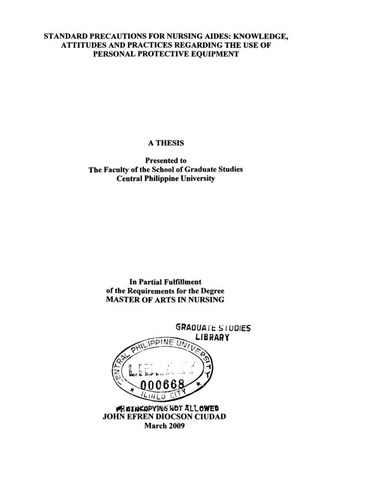Standard precautions for nursing aides: Knowledge, attitudes and practices regarding the use of personal protective equipment
摘要
The study attempted to determine the knowledge, attitudes and practices regarding standard precautions on the use of personal protective equipment among nursing aides in hospitals in Roxas City, Capiz, Philippines and the relationship between and among identified variables. Specifically, It aimed to determine the characteristics of the respondents in terms of sex, age, civil status, educational attainment, type of hospital, work status, area of assignment, number of patient assignment, and length of clinical practice; determine the relationship of personal characteristics of the respondents with their knowledge about standard precautions on the use of personal protective equipment, with their attitudes toward standard precautions on the use of personal protective equipment, and with their practices regarding standard precautions on the use of personal protective equipment.; and also the relationship between the respondents’ knowledge and attitudes, between knowledge and practices, and between attitudes and practices.
The descriptive-relational method using a one shot survey design was utilized in this study. Data were gathered using a survey questionnaire. The respondents were composed of a stratified random sample of 146 nursing aides from four hospitals in Roxas City. Statistical tools used were frequencies and means to analyze and interpret descriptive data, and chi-square and gamma tests to analyze statistical data. Relationships between variables were tested at five percent level of significance. All results were computer generated using SPSS PC software.
Major Findings of the Study
Majority of the nursing aides in the four hospitals in Roxas City were females, between 21 to 30 years old, were single, either graduates of non board paramedical courses, midwives or nurses. Majority work in private hospitals, were permanently employed, assigned in the general wards, attending to an average of 17 patients and with clinical practice of less than two years.
Their level of knowledge about standard precautions on the use of personal protective equipment was moderate, their attitudes toward standard precautions on the use of personal protective equipment were positive, and their practices regarding standard precautions on the use of personal protective equipment were fair to good. Respondents’ personal characteristics which were found significantly related to their level of knowledge about standard precautions on the use of personal protective equipment were sex, age, and work status; while their civil status, educational attainment, type of hospital, area of assignment, number of patient assignment and length of clinical practice were not.
Among the respondents’ personal characteristics tested for relationship with their attitudes toward standard precautions on the use of personal protective equipment, only work status was found significant; the rest of the personal characteristics were not.
Among the respondents’ personal characteristics which were found significantly related to their practices regarding standard precautions on the use of personal protective equipment were age, educational attainment, type of hospital and number of patient assignment. The rest of the respondents’ personal characteristics were not.
Results of the study further revealed that there was a significant relationship between respondents’ level of knowledge and their attitudes toward standard precautions on the use of personal protective equipment and between respondents’ level of knowledge and their practices regarding standard precautions on the use of personal protective equipment. However, no significant relationship was found between respondents’ attitudes toward standard precautions on the use of personal protective equipment and their practices regarding standard precautions on the use of personal protective equipment.
Conclusions
On the bases of the findings of the study, the following conclusions were made:
1. Nursing aides in hospitals in Roxas City are predominantly females, young adults, single, and graduates of non board paramedical courses. Majority work in private hospitals, are permanently employed, assigned in general wards, are handling an adequate number of patients, and are still new in their job;
2. Having only moderate level of knowledge about standard precautions on the use of personal protective equipment, nursing aides may encounter significant health risks in the workplace;
3. The nursing aides’ positive attitude towards standard precautions on the use of personal protective equipment can be considered an important element in learning about and fully implementing the guidelines set for standard precautions on the use of personal protective equipment;
4. The nursing aides’ practices regarding standard precautions on the use of personal protective equipment may result to health risks for themselves and the patients they care for;
5. The respondents’ sex, age and work status have a bearing on their level of knowledge about standard precautions on the use of personal protective equipment. Females tend to have better knowledge than males; the older ones and those who are regularly employed know more than the younger ones;
6. The school preparation and place of work reinforcements contribute to nursing aides’ knowledge and practices about standard precautions on the use of personal protective equipment;
7. The respondents’ work status has an influence on their attitudes toward standard precautions on the use ofpersonal protective equipment. Casual and regular employees exhibit better attitudes than the volunteers;
8. The respondents’ practices regarding standard precautions on the use of personal protective equipment are influenced by their age and educational attainment. The older and the more educationally trained nursing aides exhibit better practices than those who complete non board paramedical courses;
9. Nursing aides from private hospitals have better practices than those from the public hospitals. Their practice is also affected by the number of patients they attend to;
10. The respondents’ knowledge about standard precautions on the use of personal protective equipment has a bearing on their attitudes towards standard precautions on the use of personal protective equipment;
11. The respondents’ practices regarding standard precautions on the use of personal protective equipment were in accordance with their knowledge about standard precautions on the use of personal protective equipment. Their fair practices regarding standard precautions on the use of personal protective equipment reflected their moderate knowledge about standard precautions on the use of personal protective equipment;
12. The respondents’ attitudes towards standard precautions on the use of personal protective equipment have no influence on their practices regarding standard precautions on the use of personal protective equipment.
Recommendations
Based on the conclusions drawn above, the researcher recommends the following:
1. The importance of standard precautions among nursing aides as a foundation for preventing nosocomial transmission should be reaffirmed, causes of information gaps should be identified and a mechanism for regular evaluation should be provided;
2. Hospital administrators should recognize and optimize respondents’ positive attitudes toward standard precautions on the use of personal protective equipment in planning strategies to further improve the level of their knowledge and practices with regard to the implementation of guidelines for protection against infectious diseases in the workplace;
3. Hospital administrators and nursing service personnel should identify factors contributing to deficiencies in practices and prioritize high risk or dangerous behaviors for immediate corrections. Mechanisms for follow-up to assure that infection control measures are routinely in place and observed must be implemented;
4. With the permission of the respondents, information should be opened to the attention of nursing aides themselves and other members of healthcare staff and services to solicit needed cooperation. Older and more knowledgeable members of the organization may offer guidance and mentorship especially with the volunteers and the new ones;
5. Details in the school instructions, particularly those related to training of nursing aides should be evaluated and assure transfer of learning;
6. Training for nursing aides should intensify targeted health information and education programs, to be integrated into basic in-service continuing education and further education and should be evaluated routinely.
7. Nursing aides have to be reminded other professional responsibility to protect themselves and their patients. They have to be reminded that failure to adhere to standards can be considered evidence of professional misconduct and could lead to disciplinary action.
8. The improvement of practice on the implementation of standard precautions on the use ofpersonal protective equipment should be addressed among nursing aides in public hospitals for the protection of the nursing aides themselves and their patients;
9. A follow -up study along this area of investigation is recommended to further verify the findings of the present study. The practices on health service delivery usually demands consistencies at all times.
描述
Abstract only
建议引文
Ciudad, J. E. D. (2009). Standard precautions for nursing aides: Knowledge, attitudes and practices regarding the use of personal protective equipment (Unpublished Master's thesis). Central Philippine University, Jaro, Iloilo City.
文件类型
Thesis主题
部
School of Graduate Studies学位
Master of Arts in Nursing货架位置
GSL Theses 610.73072 C896
物理描述
xvii, 128 leaves




